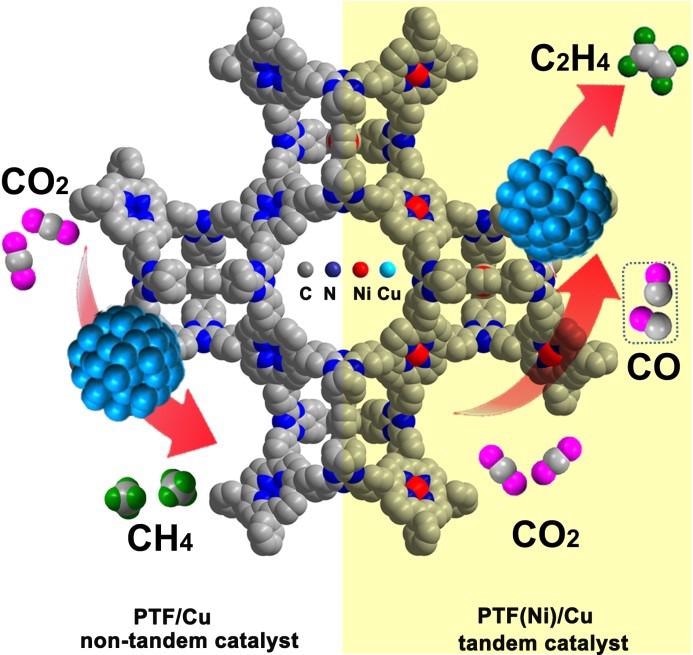The cyclic utilization of carbon resources can be achieved by the electroreduction reaction of CO2 (CO2RR) into higher-value C2+ (C ≥ 2) products like C2H4, which is an eco-friendly technology.
 The tandem electroreduction of CO2 to ethylene over atomically isolated nickel-nitrogen site/copper nanoparticle catalysts. Image Credit: Prof. Cao’s group.
The tandem electroreduction of CO2 to ethylene over atomically isolated nickel-nitrogen site/copper nanoparticle catalysts. Image Credit: Prof. Cao’s group.
However, the selectivity and activity of higher-value C2+ (C ≥ 2) products are highly restricted by the multi-electron transfer process and the very slow C-C coupling step at a single active site.
Prof. Rong Cao and Prof. Yuanbiao Huang from Fujian Institute of Research on the Structure of Matter (FJIRSM) of the Chinese Academy of Sciences (CAS) have now devised an effective tandem catalysis approach to enhance the selectivity of CO2RR toward C2H4 by various unique catalytic sites in the local vicinity. The study was reported in Angewandte Chemie International Edition.
The team developed an earth-abundant element–based tandem electrocatalyst PTF(Ni)/Cu. This was achieved by uniform dispersing of Cu nanoparticles (NPs) on the porphyrinic triazine framework that was anchored with atomically separated nickel-nitrogen sites (PTF(Ni)).
At -1.1 V, the Faradaic efficiency of C2H4 touches 57.3% in contrast to the reversible hydrogen electrode (RHE), which is nearly six times greater than the non-tandem catalyst PTF/Cu (porphyrinic triazine framework anchored with no metal), outclassing a majority of the catalysts.
PTF(Ni)/Cu exhibits optimal stability with the continuous synthesis of C2H4 over electrolysis for 11 hours, as demonstrated by the nearly unvarying total current density and FEC2H4. From the electroreduction of CO (CORR) on PTF/Cu and PTF(Ni)/Cu, it was proven that the in-situ generated CO through atomically separated nickel-nitrogen sites is highly significant. This can shift quickly to the closer Cu NPs for the subsequent C-C coupling reactions to synthesize C2H4.
Moreover, the operando ATR-FTIR and density functional theory (DFT) calculations showed that the higher concentration of local CO on Cu sites led to an increase in *CO intermediate coverage on the Cu surface. This improved the C-C coupling viability, resulting in the improved formation of C2H4. By contrast, a low CO concentration favored the synthesis of CH4.
This research put forward a simple and common synthesis approach to develop tandem catalysts based on single-atom active sites. This approach can further guide the subsequent design of new generations of highly efficient CO2RR catalysts for producing multi-carbon products.
Journal Reference:
Meng, D.-L., et al. (2021) Highly Selective Tandem Electroreduction of CO2 to Ethylene over Atomically Isolated Nickel–Nitrogen Site/Copper Nanoparticle Catalysts. Angewandte Chemie International Edition. doi.org/10.1002/anie.202111136.